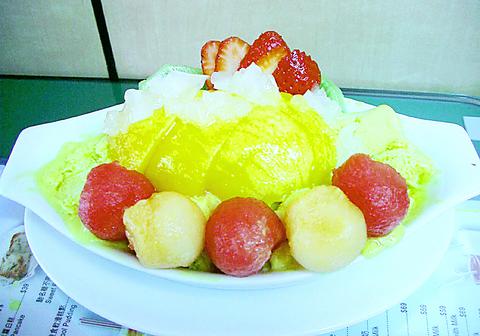In the past you had to go to Hong Kong to try Hui Lau-shan's food. Now you can find the gaudy red board with three golden-colored Chinese characters on many streets in Taiwan. In less than two months, the famous sweets and iced desserts company have opened 29 branches in Taipei, Taichung, Tainan and Kaohsiung.
This 50 year-old company offers a choice of fresh fruit juices, purees or sorbet desserts prepared with cool tapioca or coconut milk. There are more than 60 items on the menu, and each with nice mango yellow, watermelon red, and coconut white colors.

PHOTO: YU SEN-LUN, TAIPEI TIMES
Mango combo is the dish of the house. The bottom is a base of very rich sorbet made with fresh mangoes and coconut meat and milk. On top are mango slices balls of watermelon, honeydew and cantaloupe, along with strawberry and kiwi slices. Topping it all off are sprinkles and slices of coconut.
Hui Lau-shan was originally a Chinese herbal tea shop established in Hong Kong in 1950 by Hui Lau-shan's son, Hui Chi-yuk (
But as the Hui family have developed developing their products, their traditional items have are never been put aside. Sago with bird's nest is a popular item and can be mixed with watermelon or coconut or mango juice. Snow frog spawn with bird's nest mixed and coconut juice is popular among female clientele, along with two hot desserts: double-boiled snow frog spawn with rock sugar and double-boiled egg white with snow frog spawn. Tortoise jelly, hasmar and bird's nest are traditionally known for their purported ability to reduce fever. Snow frog spawn and bird's nest are also good for the skin, according to traditional Chinese medical theory.
If you've come to relieve no other ailment than a sweet tooth, then tropical fruit is what you need. Sea coconut combo is the coconut version of the mango combo. All the fresh fruit toppings are the same only with rich coconut ice cream on the base. Mango pudding with fresh fruit is another dessert that can easily fill you up. Mango pudding and a scoop of coconut ice cream on top, with watermelon, strawberry and mango added of course. Hui Lau-shan has long been known as the original Hong Kong home of mango ice desserts.
The only drawback is the price, which is about 20 percent higher than most Taiwanese crushed ice eateries. But from its popularity here in Taiwan this doesn't seem much of a problem for the management. A smart idea is to pick up the special of the day. Every day four dishes are priced from NT$69. There is also a delivery service for those ordering more than 10 servings.

In the March 9 edition of the Taipei Times a piece by Ninon Godefroy ran with the headine “The quiet, gentle rhythm of Taiwan.” It started with the line “Taiwan is a small, humble place. There is no Eiffel Tower, no pyramids — no singular attraction that draws the world’s attention.” I laughed out loud at that. This was out of no disrespect for the author or the piece, which made some interesting analogies and good points about how both Din Tai Fung’s and Taiwan Semiconductor Manufacturing Co’s (TSMC, 台積電) meticulous attention to detail and quality are not quite up to

April 21 to April 27 Hsieh Er’s (謝娥) political fortunes were rising fast after she got out of jail and joined the Chinese Nationalist Party (KMT) in December 1945. Not only did she hold key positions in various committees, she was elected the only woman on the Taipei City Council and headed to Nanjing in 1946 as the sole Taiwanese female representative to the National Constituent Assembly. With the support of first lady Soong May-ling (宋美齡), she started the Taipei Women’s Association and Taiwan Provincial Women’s Association, where she

Chinese Nationalist Party (KMT) Chairman Eric Chu (朱立倫) hatched a bold plan to charge forward and seize the initiative when he held a protest in front of the Taipei City Prosecutors’ Office. Though risky, because illegal, its success would help tackle at least six problems facing both himself and the KMT. What he did not see coming was Taipei Mayor Chiang Wan-an (將萬安) tripping him up out of the gate. In spite of Chu being the most consequential and successful KMT chairman since the early 2010s — arguably saving the party from financial ruin and restoring its electoral viability —

It is one of the more remarkable facts of Taiwan history that it was never occupied or claimed by any of the numerous kingdoms of southern China — Han or otherwise — that lay just across the water from it. None of their brilliant ministers ever discovered that Taiwan was a “core interest” of the state whose annexation was “inevitable.” As Paul Kua notes in an excellent monograph laying out how the Portuguese gave Taiwan the name “Formosa,” the first Europeans to express an interest in occupying Taiwan were the Spanish. Tonio Andrade in his seminal work, How Taiwan Became Chinese,